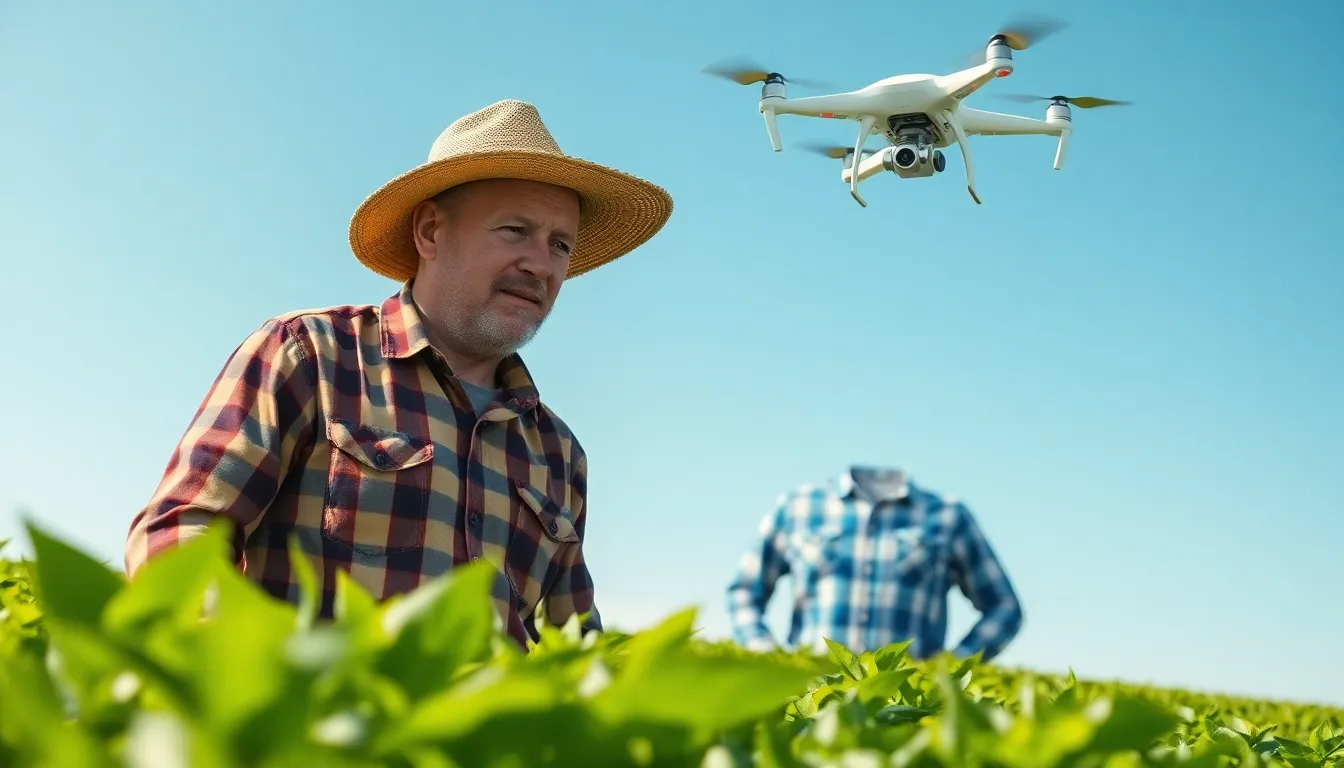In a world where the only thing growing faster than the population is the demand for food, sustainable farming technology is the superhero we never knew we needed. Imagine a farm where robots do the heavy lifting, drones keep an eye on crops, and soil health is monitored by smart sensors—all while reducing the carbon footprint. Sounds like sci-fi? It’s happening right now, and it’s about time we embraced it.
Table of Contents
ToggleOverview of Sustainable Farming Technology
Sustainable farming technology focuses on innovative methods to increase agricultural efficiency while minimizing environmental impact. Robotics play a crucial role by automating labor-intensive tasks, which allows farmers to redirect their efforts toward more strategic endeavors. Drones enhance crop monitoring capabilities, providing real-time data that aids in precision agriculture. Smart sensors assess soil health, ensuring optimal growing conditions and informing nutrient management.
Data analytics boosts decision-making processes through comprehensive insights into crop performance and yield predictions. Farmers leverage cloud computing to access and store data, facilitating collaboration and resource sharing. Additionally, vertical farming techniques optimize space usage and resource efficiency, reducing reliance on arable land.
Renewable energy sources, such as solar panels and wind turbines, help to power farming operations sustainably. These technologies lower operational costs and contribute to reducing greenhouse gas emissions. Biodegradable materials for packaging and pest control further minimize pollution and waste in agriculture.
The integration of sustainable farming technology leads to better resource management, helping ensure food security against a backdrop of climate change. As these technologies gain traction, their adoption becomes critical in promoting resilience and sustainability in agriculture. Enhanced practices strengthen supply chains and encourage responsible stewardship of land and resources.
Benefits of Sustainable Farming Technology

Sustainable farming technology offers significant advantages that address environmental and economic challenges in agriculture. Utilizing innovative methods enhances operational efficiency while safeguarding natural resources.
Environmental Impact
Sustainable farming technology substantially reduces the carbon footprint of agriculture. Adoption of practices like precision farming minimizes waste and enhances resource management. Drones facilitate accurate monitoring of crops, allowing timely interventions that preserve biodiversity. Smart sensors also assess soil health, ensuring optimal conditions for plant growth. Furthermore, renewable energy sources such as solar power help decrease greenhouse gas emissions. Sustainable methods contribute to improved water quality by minimizing chemical runoff. Overall, these practices support ecological balance and promote healthier ecosystems.
Economic Advantages
Economic benefits of sustainable farming technology are significant and multifaceted. Efficient use of resources lowers operational costs, leading to higher profit margins for farmers. Automation through robotics minimizes labor costs while increasing productivity. Data-driven decision-making strengthens supply chains and enhances response to market demands. Additionally, farmers implementing sustainable practices often qualify for grants and subsidies, reinforcing financial stability. Long-term investments in technology may yield substantial returns, driving profitability. Adopting sustainable methods ensures resilience against economic fluctuations and enhances competitive advantage in the market.
Types of Sustainable Farming Technology
Sustainable farming technology encompasses various innovative practices designed to enhance agricultural efficiency while reducing environmental impact. This section explores key categories of such technologies.
Precision Agriculture
Precision agriculture employs data analytics, GPS, and IoT devices to optimize crop yields and minimize resource waste. Farmers use satellite imagery for detailed analysis of soil and crop health. Sensors placed in fields collect real-time data on moisture levels and nutrient content. This information enables targeted interventions, ultimately leading to lower usage of water and fertilizers. By adopting precision agriculture techniques, growers can significantly enhance productivity while preserving soil health and biodiversity.
Renewable Energy Solutions
Renewable energy solutions play a vital role in sustainable farming. Solar panels and wind turbines generate clean energy, reducing reliance on fossil fuels. Many farms utilize biogas from organic waste for electricity and heating. Such practices not only cut operational costs but also decrease greenhouse gas emissions. Integrating renewable energy solutions fosters energy independence in farming operations, allowing producers to invest in additional sustainable practices and technologies.
Challenges in Implementing Sustainable Farming Technology
Implementing sustainable farming technology presents several challenges that hinder widespread adoption. Understanding these obstacles is essential for overcoming them.
Financial Barriers
Financial barriers significantly impact farmers’ ability to transition to sustainable practices. High initial costs for equipment and technology deter many from investing in sustainable solutions. Limited access to capital affects small-scale farmers disproportionately, making it difficult for them to adopt advanced tools. Additionally, uncertain returns on investments create reluctance to make long-term financial commitments. Grants and subsidies can alleviate some of these concerns, but many farmers lack awareness of available resources. Ensuring that financial support reaches farmers would improve adoption rates of sustainable farming technologies.
Technological Limitations
Technological limitations pose another challenge in sustainable farming. Some regions lack access to high-speed internet, hindering the use of data-driven technologies such as precision agriculture. Limited technical knowledge also restricts farmers from fully utilizing advanced tools. Equipment can sometimes be too complex, preventing efficient integration into existing practices. Moreover, compatibility issues between different technologies can complicate operations. Addressing these technological barriers through training programs and improved infrastructure is essential for achieving sustainable agricultural goals.
Future Trends in Sustainable Farming Technology
Emerging trends in sustainable farming technology shape agriculture’s future. Innovations such as artificial intelligence increasingly enhance decision-making processes. Automated systems simplify labor-intensive tasks, enabling farmers to focus on strategic management. Vertical farming continues to gain traction, optimizing land use in urban settings.
Robotics play a pivotal role in increasing efficiency. Automated tractors and harvesters reduce the need for manual labor while improving precision in planting and harvesting. Additionally, drone technology evolves rapidly, offering advanced capabilities in monitoring crop health and irrigation needs.
Sensors and IoT devices enable real-time data collection, transforming farming practices. This technology allows seamless integration of data analytics, supporting tailored interventions that boost crop yields while conserving resources. Increased reliance on renewable energy further strengthens sustainability efforts in agriculture.
Blockchain technology offers transparency in food supply chains, enhancing traceability from farm to table. Farmers benefit from improved market access and accountability through secure transaction processes. Enhanced data sharing fosters collaboration among producers, optimizing resource management and farming techniques.
Furthermore, the rise of biopesticides and biofertilizers aligns with ecological conservation goals. These sustainable alternatives reduce chemical usage, promoting biodiversity and healthier ecosystems. Finally, community-supported agriculture (CSA) models encourage local food systems, connecting consumers directly with food producers.
Overall, advancements in sustainable farming technology present powerful opportunities to address food security, resource management, and environmental challenges. Investment in these technologies enhances competitiveness while prioritizing ecological stewardship.
Sustainable farming technology represents a pivotal shift in agricultural practices. By embracing innovations like robotics drones and smart sensors, farmers can enhance productivity while reducing their environmental impact. These technologies not only improve resource management but also contribute to food security in an era of climate change.
The potential for growth in this sector is immense. As barriers to adoption are addressed through training and improved infrastructure, more farmers can leverage these advancements. This transformation will not only benefit individual farmers but also foster a resilient agricultural landscape that prioritizes ecological balance and sustainability. The future of farming lies in these sustainable solutions, ensuring a healthier planet for generations to come.






